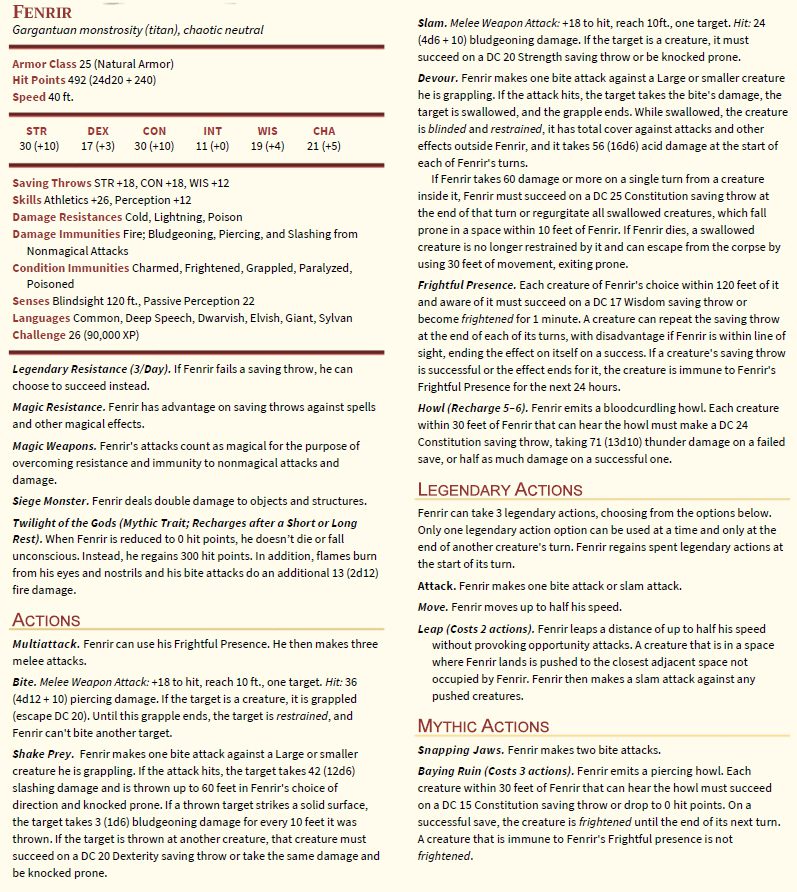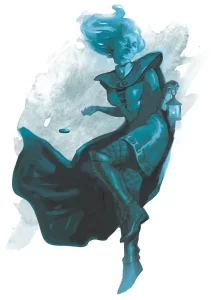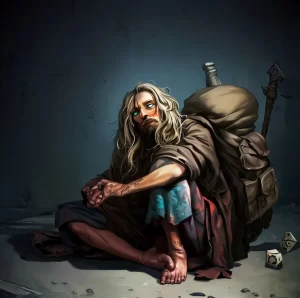
In the shadowy corners of legend and horror, no name resonates with more terror than that of the Wolf of the Fens. Fenrir, also known by titles like "Fame-wolf," "the Ravener," and "Bane of the High One," is a monstrous entity whose very existence sends shivers down the spine of those who dare utter his name. The skalds (Nordic poets) have immortalized him in their haunting verses, but words cannot fully capture the dread that he embodies.
Fenrir is not merely a wolf but a nightmare brought to life-a creature of gargantuan size and horrific strength. Born of the unholy union between Loki and the Jötunn Angrboða, Fenrir's very lineage reeks of malice and chaos. Alongside his sister Hel, the cold ruler of the dead, and his brother Jörmungandr, the world-serpent, he stands as one of the three harbingers of the apocalypse that will unleash itself at the Twilight of the Gods.
The Æsir, knowing the devastation Fenrir was destined to cause, were consumed by terror and desperation. They turned to the master dwarven smiths Brokkr and Eitri, commissioning a chain unlike any other. Named Gleipnir, this unbreakable magical chain was as thin as a spider's thread, yet strong enough to bind the horror that was Fenrir. It looked like nothing more than a delicate silk ribbon, but it concealed a power most profound.
Fenrir's eyes, aglow with malice, saw through the gods' treacherous intentions, but he agreed to their challenge, demanding Týr's hand within his jaws as insurance. The moment of binding was fraught with tension, a terrifying dance with destiny, and it ended with Týr's scream as his hand was severed.
Henceforth, Týr became "the one-handed god," a grim reminder of the terror that was Fenrir.
Wolf Unbound. No bond can hold Fenrir-no chain can contain this monstrous terror except for Gleipnir, a magic chain forged from six impossible components. But when Ragnarök descends, even Gleipnir will snap, and Fenrir will be unleashed upon the world. He will march with his siblings, a nightmarish vanguard against the Æsir. The earth will tremble and skies will darken as Fenrir faces Odin, the All-father, eventually swallowing him whole in an act of savage triumph.
In a final act of divine vengeance, Odin's son Víðarr will slay Fenrir, tearing his massive jaws apart. But the horror of the Wolf of the Fens will linger, a terrifying legacy that no heroism can erase, a shadow forever etched in the annals of fear and dread.

Fenrir numbers among the most powerful creatures a group of adventurers might face. If you wish to make an encounter with the Fenris Wolf truly legendary, Fenrir might use its Twilight of the Gods mythic trait. When this happens, it calls upon a reserve of strength just as it appears to be vanquished and heralds the end of an age. Fenrir can choose one of its mythic actions when it uses a legendary action.
Fenrir uses its Twilight of the Gods Trait:
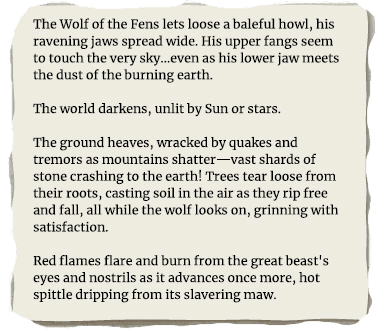
Fighting Fenrir as a mythic encounter is equivalent to taking on two CR 26 creatures in one encounter. Award a party 180,000 XP for defeating Fenrir after it uses Twilight of the Gods.

Fenrir is a figure of godlike (and God-devouring) stature. A showdown with Bane of the High One will commonly take place as the final set piece battle at the of the world in Ragnarök-themed campaign. Before reaching this point, a party of heroes will likely have many levels of experience, high-powered magical artifacts and supernatural gifts like divine blessing and epic boons all at their disposal.
Find complete stat block and description here: Fenrir
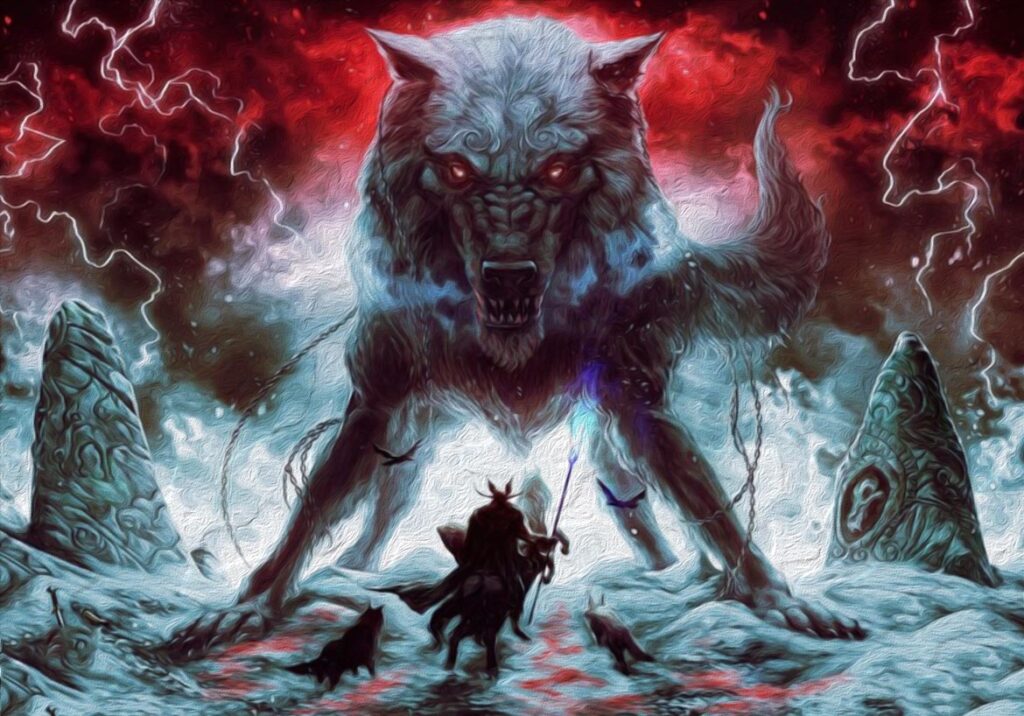
Legendary Resistance (3/Day). If Fenrir fails a saving throw, he can choose to succeed instead.
Magic Resistance. Fenrir has advantage on saving throws against spells and other magical effects.
Magic Weapons. Fenrir's attacks count as magical for the purpose of overcoming resistance and immunity to nonmagical attacks and damage.
Twilight of the Gods (Mythic Trait; Recharges after a Short or Long Rest). When Fenrir is reduced to 0 hit points, he doesn't die or fall unconscious. Instead, he regains 300 hit points. In addition, flames burn from his eyes and nostrils and his bite attacks do an additional 13 (2d12) fire damage.
Multiattack. Fenrir can use his Frightful Presence. He then makes three melee attacks.
Bite. Melee Weapon Attack: +18 to hit, reach 10 ft., one target. Hit: 36 (4d12 + 10) piercing damage. If the target is a creature, it is grappled (escape DC 20). Until this grapple ends, the target is restrained, and Fenrir can't bite another target.
Shake Prey. Fenrir makes one bite attack against a larger or smaller creature he is grappling. If the attack hits, the target takes 42 (12d6) slashing damage and is thrown up to 60 feet in Fenrir's choice of direction and knocked prone. If a thrown target strikes a solid surface, the target takes 3 (1d6) bludgeoning damage for every 10 feet it was thrown. If the target is thrown at another creature, that creature must succeed on a DC 20 Dexterity saving throw or take the same damage and be knocked prone.
Slam. Melee Weapon Attack: +18 to hit, reach 10ft., one target. Hit: 24 (4d6 + 10) bludgeoning damage. If the target is a creature, it must succeed on a DC 20 Strength saving throw or be knocked prone.
Devour. Fenrir makes one bite attack against a larger or smaller creature he is grappling. If the attack hits, the target takes the bite's damage, the target is swallowed, and the grapple ends. While swallowed, the creature is blinded and restrained, it has total cover against attacks and other effects outside Fenrir, and it takes 56 (16d6) acid damage at the start of each of Fenrir's turns.
If Fenrir takes 60 damage or more on a single turn from a creature inside it, Fenrir must succeed on a DC 25 Constitution saving throw at the end of that turn or regurgitate all swallowed creatures, which fall prone in a space within 10 feet of Fenrir. If Fenrir dies, a swallowed creature is no longer restrained by it and can escape from the corpse by using 30 feet of movement, exiting prone.
Frightful Presence. Each creature of Fenrir's choice within 120 feet of it and aware of it must succeed on a DC 17 Wisdom saving throw or become frightened for 1 minute. A creature can repeat the saving throw at the end of each of its turns, with disadvantage if Fenrir is within line of sight, ending the effect on itself on a success. If a creature's saving throw is successful or the effect ends for it, the creature is immune to Fenrir's Frightful Presence for the next 24 hours.
Howl (Recharge 5-6). Fenrir emits a bloodcurdling howl. Each creature within 30 feet of Fenrir that can hear the howl must make a DC 24 Constitution saving throw, taking 71 (13d10) thunder damage on a failed save, or half as much damage on a successful one.
Here is a stat block for Fenrir:
